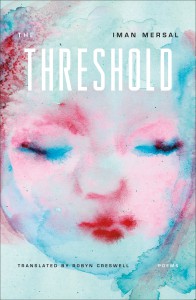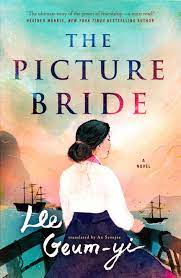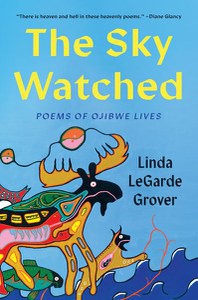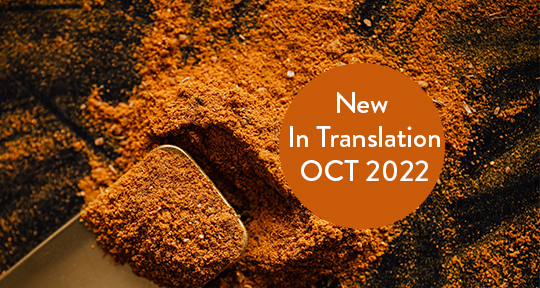In this month’s round-up of the latest in world literature, our editors bring vital texts addressing faith, (false) mythologies, desire, migration, and Indigenous culture to the forefront: a collection of penetrating, prismatic poems from the lauded Egyptian poet Iman Mersal; from South Korea’s Lee Geum-yi, a fiction that tells the long-silenced stories of women crossing the seas to be wed to strangers; and a new collection of poetry, documenting Ojibwe lives, by eminent writer Linda LeGarde Grover. Read on to find out more!

The Threshold by Iman Mersal, translated from the Arabic by Robyn Creswell, Farrar, Straus and Giroux, 2022
Review by Alex Tan, Senior Assistant Editor
Perhaps it begins with a search. The Egyptian poet Iman Mersal returns to her homeland in hopes of procuring a book by Saniya Saleh, an elusive writer no one seems to have heard of. Instead she finds a table, piled with the canonized words of men; nowhere in sight is the person she seeks: a wife, sister, and mother, who can only secondarily be a writer in her own right. “I don’t know how she likes to see herself,” she laments in a wandering essay. Left with the “wasted potential” of what survives, she can imagine only a voice of muted cadence, “a whispered song of mourning which slips through to me amid the din of revolutionaries’ rabble-rousing slogans, of warriors intent on victory, of those broken by defeat angrily denouncing state, dictator and society.”
A similar quality of whispering, of slipping through, inhabits Iman Mersal’s angular The Threshold, a collection of poetry translated delicately by Robyn Creswell in conversation with the poet herself. In the titular piece, a collective biography of sorts charts a path through the streets and labyrinthine hypocrisies of Cairo in the nineties: “one long-serving intellectual screamed at his friend / When I’m talking about democracy / you shut the hell up.” Elsewhere a speaker ventures, “Let’s assume the people isn’t a dirty word and that we know the meaning of en masse.” Yet this momentary compact reveals its own fragility; language with all its alibis and forms of subterfuge seems a poor vessel, too riddled with holes to hold “all the wasted days” and the “nights / of walking with hands stretched out / and the visions that crept over the walls.”
Mersal’s work is unafraid of its own promontories and edges. Often, the writing advances a crepuscular view of the self, ever-partial and shrouded in semi-obscurity, divided from its figurations. The opening poem dryly declares, “I’m pretty sure / my self-exposures / are for me to hide behind.” Her name, which contains the Arabic for “faith” and “messenger,” is too “musical” for “a body like my body / and lungs like these—growing raspier / by the day.” On what map might we locate the trembling contours of that occluded life, “whose existence I’ve never been sure of,” and which appears to “have neither past nor future” in an encounter with a stranger, on whose shoulder she accidentally falls asleep? How unwieldy it feels in its bulk, how relentlessly it has been anatomized, in spite of its wispy resistance to measurement:
This is the life into which more than one father stuffed his ambitions, more than one mother her scissors, more than one doctor his pills, more than one activist his sword, more than one institution its stupidity, and more than one school of poetry its poetics.
That vacillating between the abstract and the resolutely material, scissoring the poetic plane, might be a signature of Mersal’s mercurial style. Conventionally regarded as a central member of the nineties generation that championed the qasidat al-nathr (prose poem), she consciously rebelled against the mythologies associated with Arab nationalist discourse. Apart from writing, she founded the feminist magazine Bint al-Ard and translated Charles Simic and Waguih Ghali into Arabic. She refined, in these crucibles of her own making, a taste for what Creswell calls the “everyday surreal”; an art of dwelling in the minuteness of the ordinary. In one particularly Kafkaesque poem, a clarification emerges that she is “not being metaphorical / about the wall” separating her from the lover in the adjacent room. Even when poised for more fanciful flights, the images remain tethered to a solid boulder of reality and critique: I grinned at lines like “In my family, children were like the harvest: one half went to the government.” Or when a man decides to “explain to me what love is”:
In the half-lit room he murmured, “Love is actually a quest for . . .”, I opened my eyes and saw a band of conquistadors searching for gold in remotest Chile, hungry and dejected, while an Indian crouches behind a rock in fear. And when he said, “Love is being truly content with . . .”, I began to hear the voice of Ella Fitzgerald and pressed my fingers into a mound of black chocolate. And when he said, “It is a happiness which . . .”, well, I really couldn’t imagine anything at all.
Such fugitive turns and inflections and trailings-off, preserved so scrupulously in this translation, seem to catch the words red-handed at their own game. Betrayal and infidelity, as Creswell notes in his introduction, are elevated into an aesthetic principle; disavowal must occur before reinvention. Hence the snark leveled at poetry, its endless unsparing revisions of its own coordinates. Writing of love, she implicates herself: “If you happen to be an Arab poet / you must have written something about it by now.” While a tourist to Elmina Castle and the Middle Passage, she satirizes her own desire to “turn whatever happens to me into heart-wrenching prose.” A description of a migraine beginning “My two hands aren’t enough to prop my head up” is abandoned, and yields to “A bullet from an unseen gun,” “the pleasure / of arousing the sore spots / simply by remembering them.” Yet the errors and crossings-out remain intact, the intention as substantial as execution, exposed for all to see.
Just as language is bound to shed its own skin, so too must we confront our finitude. No “feeling of loss” overtakes this persona whose “body is a large woven basket” where the dead “have left / their traces.” Bearing phantom impress of their entrances and exits, Mersal’s writing gives itself over to be repossessed. She berates her father for making her think “the world is like a school for girls / and that I should set aside my desires / just to be first in the class”; lies without compunction about losing her mother at six, before promptly confessing “the truth / is that I was seven / but six seems so much more pathetic”; memorializes her literary comrade Osama al-Danasouri by imagining an email dispatched from “what some call the other world,” a pleasant locale where “no mosques or minarets, no Ministry of Culture, no public buses” exist to be dealt with.
The earlier works anticipate, almost uncannily in their detachment, the horizon of alienation and exile that clouds much of the collection’s latter half. As a migrant in Canada, she can observe, “Here as well as there / life seems to exist only to be watched from afar.” Across these collisions lies a fascination with the evanescent, the thresholds cleaving between an event and the evidence of its aftermath. On Google Earth, the shape of Mit ‘Adlan, her village of birth, “looks like a broken watch left on a wall that used to hold up a house.” Patterns on a carpet bloom into “flowers that might still be wet / with the breath of two bodies that never had enough time / and so took pleasure in their mounting terror.” One of the most macabre pieces sketches a portrait of “ones who were torn to shreds,” the catastrophe looming but left unnamed. In their brokenness, “each of them looks exactly like himself—canceled stamps, unfixed from their envelopes, which ended up in some philatelist’s album.” Deferred from their destination, many of the poems read like missives of faith addressed to a shadowy, mirrored world of choices unmade and lives unlived, now assuming the force of a haunting.
A prayer rounds off the volume: that home “be a wall whose cracks keep growing until one day you take them for doors.” Mersal’s work is buoyed by that wish, the way it fractures into an openness, suspended as if in the middle of nowhere. Claire Schwartz has written, “Poetry is a door without a house.” May we hear those unsheltered whispers from the other side now slipping, with all the gravity of a search provisionally concluded, over the threshold.

The Picture Bride by Lee Geum-yi, translated from the Korean by An Seonjae, Forge Books, 2022
Review by Ah-reum Han
Through The Picture Bride, English-speaking fans of historical fiction are introduced to one of South Korea’s prolific and beloved storytellers, Lee Geum-yi. While Lee has over fifty books with work translated into several languages, this novel is her English language debut, opening up the way for anglophone readers to imagine and experience the changing fortunes of Korean picture brides—women selected from photographs to marry Korean immigrant workers in Hawai’i during the early twentieth century. This novel honors those powerful Korean women, who took a chance on a new life in a distant land.
In the author’s note, Lee describes how the seeds of this book germinated from her own readings on Korean-American immigration from the last century. Encountering images of picture brides for the first time in her research, Lee wondered:
How could women think of setting off for a distant place when it was difficult even to go to the local market? What made you risk your fate on a single picture? Where did that courage come from? What kind of people were the husbands when they arrived in Hawai’i? What was life like in a strange place?
Lee’s gentle curiosity comes through in the way she textures this quiet corner of history. She is patient and exact in her worldbuilding, anchoring readers in the lived emotional reality of the protagonist, Willow, and her friends Hongju and Songhwa. Through Willow, we also meet the many other young women who left everything, lured by the shiny promise of an American life to men they had never met—many of whom fail to live up to their paper promises. As Willow and her friends travel farther and farther from their small Korean village, crossing land and sea to settle into their new homes in Hawai’i, what survives the journey?
Willow and her friends must deconstruct the way that their world worked before: the class structures, the power dynamics, and the superstitions of their hometown in Ojin, South Korea. At times, the world they reconfigure from its pieces echoes the broken structures of what they left behind. We watch Willow struggle to find her place within unfamiliar lines drawn by nation and race in this new country, while also navigating the increasingly complex relations within a splintering Korean-Hawaiian community. With this twice othered status, Willow gives readers a unique perspective into the tumultuous socio-political climate of the time. This is a story of collective outsiders, of being strangers together in a strange land.
Willow and Hongju come to see their lives as “a kind of surfing,” in the choppy waters of a life that never seems to turn out the way one expects. Taking on the responsibilities of wife, daughter-in-law, mother, businesswoman—and often forced to do so alone—she must reimagine what each of these roles means. Willow and her friends struggle to make ends meet, impacted inevitably by the escalating Korean independence movement against the Japanese occupation, witnessing history up to the events of Pearl Harbor and World War II. As we follow Willow through the decades, she shows us the day-to-day longing, resilience, and resourcefulness necessary to survive. In the end, there is familiarity in the strange: “The country they had been told was a paradise was just like Korea, a country stolen.”
For both our author and our protagonist, this is a story that began with an image. So it is fitting that photographs play such an important role in propelling the narrative and in grounding the three-part structure of the book. Each of the three parts pivots on key photographs, which drive narrative tension, frame key decisions, and offer readers the vivid visuals of the world, the people in it, and the lives they hoped to lead. Each visual seed is treated with care. In the closing act of the book, we find photographs used as a vehicle to anchor themes of multigenerational trauma, and new ways of being othered as a second generation immigrant—this time the separation between parent and child. Told in gentle, empathetic prose that sheds new light into a neglected corner of American history, The Picture Bride is an immigrant story, but it is moreover a love story to all the married immigrant women adventurers, pioneers, and trailblazers then and today.

The Sky Watched by Linda LeGarde Grover, University of Minnesota Press, 2022.
Review by Eva Wissting, Editor-at-Large for Sweden
“Migwechiwendam Ojibwemowin” is the title of one of the last poems in Linda LeGarde Grover’s latest collection, and the only poem that is entirely in the Ojibwe language, sometimes referred to as Anishinaabemowin. From the lauded Anishinaabe writer, also known for her novels and essays, The Sky Watched is a bilingual poetry book, laying out and braiding the English and Ojibwemowin in poems that explore linguistic intention, ethics, and definition. Its wide range and elegant context provides entry for English readers who may or may not be familiar with the Ojibwe language, and who may or may not be familiar with culture or experiences of the Ojibwe people.
The Ojibwe are Indigenous people of the northern parts of Midwestern US and the southeast of Canada, centered around the Great Lakes. UNESCO considers their language at high risk of extinction, since native speakers are counted in the thousands, and they are mainly elderly. However, many language revitalization efforts are made, and there is today a growing number of second-language-learners of Ojibwemowin. An essential part of keeping a language alive, of course, is the preservation and spreading of its stories and literature, and LeGarde Grover’s book is a beautiful example of such a storytelling effort. Ojibwemowin is used in The Sky Watched to relate the specific culture and experience of Ojibwe people—both painful as well as experiences of community, joy, and hope.
As someone who has spent a lot of time in Canada the last few years, and hardly any in the US, I’m much better informed about the Canadian history of attempting to extinguish Indigenous people, their culture, and their languages, not least through the residential school system. What I learn from The Sky Watched is that, unsurprisingly, the situation has been very much the same south of the border, removing children from their families in order to rob them of their culture, their beliefs, and their language.
While most poems in LeGarde Grover’s book blend Ojibwemowin words in with the English, some of the poems are in English only, like in “Everything You Need to Know in Life You’ll Learn at Boarding School”:
Speak English. Forget the language of your grandparents. It is dead. Forget their teachings. They are ignorant and ungodly. Cleanliness is next to Godliness. Indians are not clean. Your mother did not teach you to be clean. Stand in line. You will learn cleanliness. This is a toothbrush. Hang it on the hook next to the others. Do not allow the bristles to touch. This spreads the disease that you bring to school from your families. Make your bed with mitered corners.
This is the only poem in the collection with short, cut-off sentences, arranged in prose form; all the other poems have a more conventional layout. Overall, the language is straightforward, often focusing on details in the physical surroundings, making each location vivid and present through the various voices of siblings, parents, and grandparents throughout the book.
Without avoiding any of the difficult subjects of broken families, abuse, violence, and racism, LeGarde Grover still manages to balance the darkness with hope throughout the text. The above poem about boarding school, where the native language of the children is declared “dead,” is followed by a poem which includes a lot of Ojibwemowin, iterating the failure of the boarding school teachings through a love story—which is also a story of survival. In spite of being sent to different boarding schools, LeGarde Grover’s grandparents Elias and Victoria found their way back to each other:
Aapii Elias gaye Victoria giigizhigiiwad, gii wiidigewag
gii-izhaawag Onigamiising.
When Elias and Victoria grew up, they got married.
They went to Duluth.Noongoom, LeGardes odoobiitanawaa Onigamiising.
Noongoom ingiw LeGarde abinoojiwag aanawa endaawaad.
Gikinoo’imawaawag amaadii wigamong Onigamiising imaa.
Noongoom LeGardes maamawi-ayaawag.Minwendaanwaa dash.
Today the LeGardes live in Duluth.
Today the LeGarde children live at home.
They go to school in Duluth.
Today the LeGardes all live together.
And they are happy.
The poems are divided into four parts: “Oshkabinoojiinh awi,” “Abinoojiinh awi,” “Anishinaabewi,” and “Gichi-Anishinaabewi.” The titles, as explained in the foreword, simultaneously follows the four ages of humans, as well as the ages of the Earth, from infancy and childhood to adulthood and old age. The first part of the book establishes the Ojibwe worldview, while the second part focuses on the damaging impact of the boarding school system. Part three is about survival, and part four takes us to the present time, tying everything together.
In fact, the very last poem of the collection is about the importance of gratitude, and in an afterword, the poet herself asks how she can express her appreciation to those around her who made the book possible—and she concludes that: “the old Ojibweg say, migwech is enough.” The work done by Legarde Grover is important for Ojibwe people, but equally as vital for all of us; the loss of a language and a culture must be met with resistance, courage, and gratitude for what remains.
*****
Read more on the Asymptote blog:

